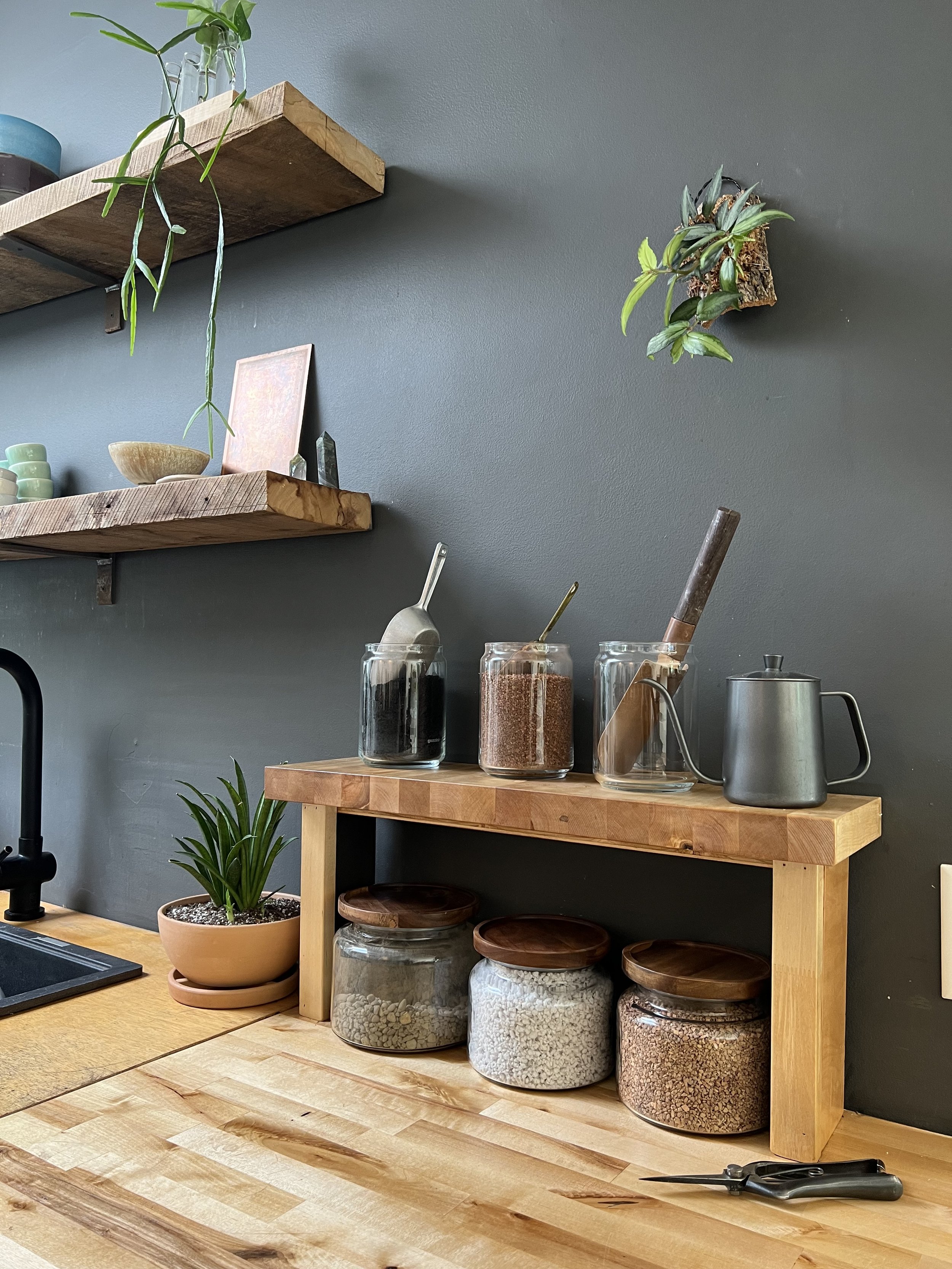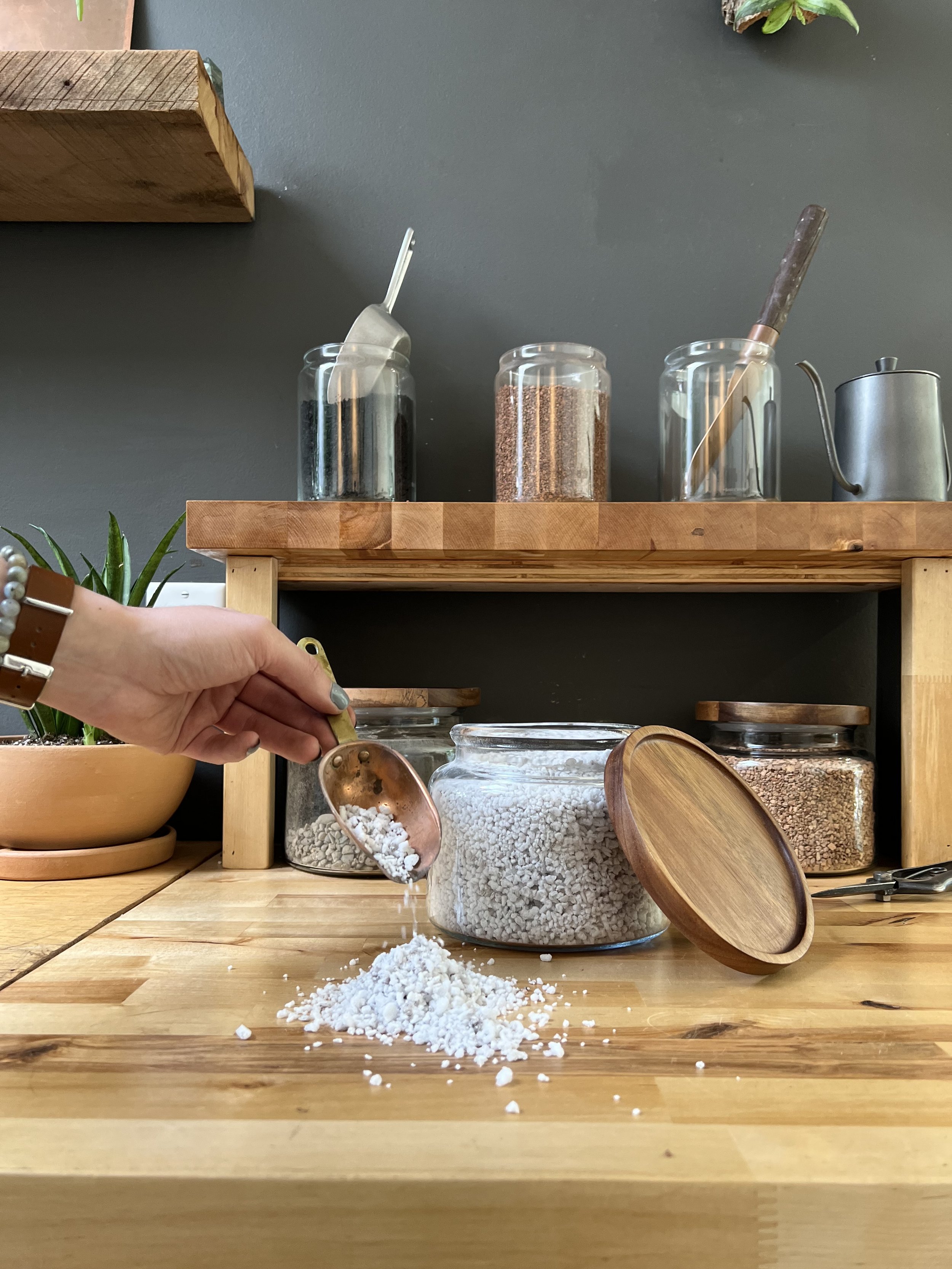Let's Talk About Potting Mix!
When you think of plant care, the first things that tend to come to mind are sunlight and water—after all, they’re the essentials that plants need to live and thrive. But, plant care can be as simple or as complex as you want to make it, and custom-mixing your own potting mix can be a way to take your plant care skills to the next level.
Using the appropriate kind of potting mix for your plants is something additional you can do to help your plants grow their best and happiest. The ideal potting mix composition can look different for different plants, and we’re here to walk you through the various amendments and why using a biologically-appropriate potting mix can be beneficial for your plants.
Mimicking what nature provides
When taking a new plant home, you’ll want to emulate the conditions they receive in nature, and this can include what type of soil—or lack thereof—they grow in.
For the same reasons that potting a cactus or succulent plant in a heavy, watering-retaining mix doesn’t jive with their thin, shallow root system, potting a moisture-loving plant in potting mix that barely retains water doesn’t work well—it’s just not similar to what these plants receive in their natural environment, and it’s not what their root systems are built to handle.
Crafting and creating a more ideal blend of potting mix for your plants tailored to their individual needs will mimic the conditions they grow in and lead to an overall healthier plant and a better experience for you as a plant caretaker.
Potting mix amendments
The following are a list of amendments you can add to your standard potting mix to elevate them and help your custom mixes emulate what your plants receive in their natural environment.
Perlite - a naturally-formed, expanded volcanic glass that is lightweight and creates additional drainage in potting mixes. Will float more towards the top of the potting mix over time.
Pumice - porous, volcanic rock that creates additional air pockets and drainage in potting mixes. Helps absorb excess water, and—unlike perlite—doesn’t float to the top of the potting mix.
Orchid bark - typically sourced from coniferous trees. Like pumice, orchid bark will absorb excess water and help create air pockets in your potting mix. Plants such as orchids should be planted entirely in bark rather than conventional potting mixes.
Horticultural charcoal - similar to pumice in that this amendment holds onto some water but also creates additional drainage in your potting mixes. One added benefit is that charcoal is naturally anti-microbial and can help stave off bacteria in your potting mix.
Sphagnum moss - a long-fibered, dried moss that has great water retention capabilities. This is typically used to root up plant cuttings easily, and it can be used as a growing medium to mount epiphytic plants onto pieces of cork bark.
Potting mix ratios
Every type of plant will have its own unique wants and needs as far as potting mixes go, but the following can serve as a baseline guide to aim for when crafting your own potting mix, or if you’re looking to purchase pre-made potting mixes for your plants.
Cacti/Succulent Potting Mixes
When you think of cacti and succulent-type plants, they typically conjure images of rugged terrain, harsh desert topography, and grit—lots of grit. When you craft or purchase a potting mix made for these types of plants, you’ll want something that contains a lot of amendments like pumice, activated charcoal, and bark. You might want to try something that’s about 75% amendments to 25% standard potting mix.
Ideally, these mixes will dry out fast between waterings. Cacti and succulents have shallow, sensitive root systems that don’t enjoy sitting in too much water for too long—their fleshy stems and leaves have better water-storing capabilities than the roots. Having a potting mix that is made up of mostly amendments will allow water to pass through quickly and efficiently.
Epiphytic Potting Mixes
Epiphytes are any type of plant that naturally grow out of the ground, typically being found in crevices of trees or growing on tree branches in rainforests. Well-loved plants like Hoyas, Dischidias, Peperomias, jungle cacti, and certain ferns all fall into the epiphyte category. Since they grow on trees and not in soil on the ground, their roots get a ton of exposure to air, and whatever potting mix you use should try to reflect that.
Similar to cacti and succulents, these potting mixes should dry out quickly between waterings but can hold onto water for a bit longer. A good epiphytic potting mix might include roughly 40% potting mix with the remaining 60% being amendments. You’ll want the mix to feel fairly chunky, allowing air to pass through the soil, mimicking how they grow in their natural environments.
Aroid Potting Mixes
Aroids are more of an umbrella family of plants consisting of Monsteras, Epipremnums, Syngoniums, Philodendrons, and more. Aroids will typically begin their life growing terrestrially (in the ground), and then at some point they’ll attach their aerial roots to vertical surface—like trees—and grow up those.
Most of these plants have thinner leaves than our succulent and epiphytic friends, and because of this, they’ll want their potting mix to retain a little bit more water. Crafting a mix that is roughly 50% potting soil and 50% amendments will allow your aroids to keep the water they need while still promoting good drainage and air around the roots.
It doesn’t have to be an exact science by any means, but adding extra amendments to your potting mix can do wonders for your plants by creating small air pockets in the soil, which when present will vastly decrease the chances of bacteria—like root rot—beginning to grow and take hold.
Words by: Egan Thorne
Photos by: Egan Thorne & Sebastian Muñoz



